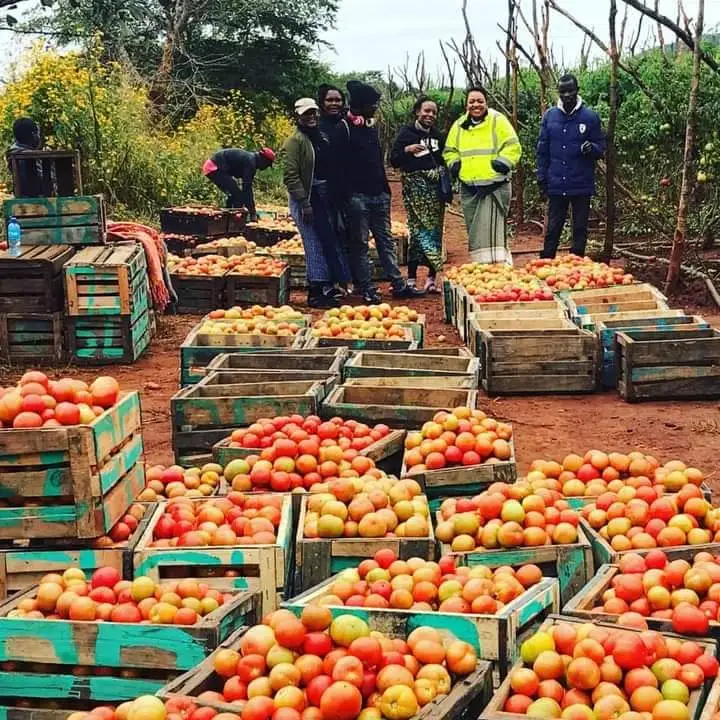
Tomato is a vegetable locally produced and highly consumed in Uganda. Almost on a daily basis every person has to eat a tomato in their food.
Common Tomato Varieties Grown
The choice of a Tomato cultivar is based on fruit quality, adaptability and reliability, susceptibility to diseases and pests.
Varieties include – Money maker, Rio Grande ,Tengeru 97, Asila F1, Chantan F1, Anja F1, Star and many more others
- It’s advisable to go for a hybrid seed for commercial farmers since these seeds are high yielding, resistant and produce durable fruits.
Tomato Growing Requirements
Tomatoes give good results when grown in well managed sandy loams and heavy clay loam free of hard pan.
Best results are obtained in deep, well drained loams. The soil should be rich in organic matter and plant nutrients, with a pH value of 6 to 7
Propagation of Tomatoes
Tomatoes are best brought up using seeds. However you can also use cuttings from mature plants to get more seedlings
Nursery Preparation
You can Broadcast the seeds on the raised bed and lightly cover with soil. Or else you can create shallow lines using your finger and place the seeds there, then cover with little soil.
Transplanting
In one acre, you plant over 8000 plants with a spacing of 2*2ft. Seedlings are usually ready for transplanting 2-3weeks after sowing, and they must be transplanted on moist soil.
At transplanting you may use a fertilizer like DAP, place a few granules in the hole, Cover with some soil, then plant your seedling.
Of you can use farm yard manure, you apply 2 hand fulls in each hole, mix it with soil and transplant.
Management
1. Fertilization
Tomatoes are heavy feeders of plant nutrients including nitrogen, phosphorus and potassium. The plant responds well to organic fertilizers too.
After 1 month from planting, you have to start applying folliar fertilizers like Vegimax to boost the growth of the crop.
2. Weed control
These can be controlled chemically or mechanically. Alternatively hand hoes can be used to shallowly plough off the weeds. Avoid using herbicides when the plants are already in the field
3. Pruning
this practice influences the flowering and fruiting of tomato plants. Prune plants by pinching off lateral branches as they appear in the leaf axils.
The more you reduce excess leaves and branches, the more space you leave for the plant to use nutrients for fruit development.
4. Mulching
Mulch newly planted tomatoes in order to retain moisture in the soil and avoid weeds from growing.
A heavy mulch is very good for our tomatoes plants. You can use dry grass, saw dust, coffee husks and many others.
5. Pest control
You have to control the insects and diseases that normally attached k the tomatoes. Normally tomatoes are affected by insects and Fungal infections.
Here you need to start applying an Insecticide (Dudu Acelamactine/Cyperscope) and a Fungicide (Mancozeb/Indofil) at once. Then spray every week starting from 1 month till flowering.
It’s good to seek advice from a plant doctor before buying any chemical to spray.
6. Stalking
After the tomatoes have grown, the stems become vulnerable and weak hence need support. You can use strings tied upwards or you can tie logs of trees on each plant. This is more effective on high yielding tomatoes since they take long.
7. Irrigation/watering
After planting your tomatoes, you must water them if it’s off season or in times of no rain. You have to water evening or morning.
8. Harvesting
After transplanting, you can start harvesting at 2 and half months. For hybrid high value varieties, you can harvest for the next 6 months
Harvest your tomatoes before they get to fully ripen. It’s advisable to leave some inches of a stalk on the fruit as you harvest, this will keep it fresh for sometime.
Pre-harvest interval for tomatoes if 2weeks, after spraying with pestcides, you have to wait for 2 weeks to harvest.https://www.monitor.co.ug/uganda/magazines/farming/complete-guide-to-open-field-tomato-farming-3451316
